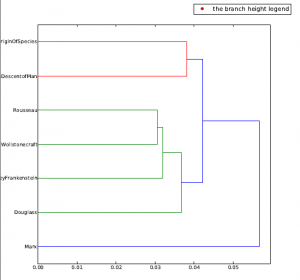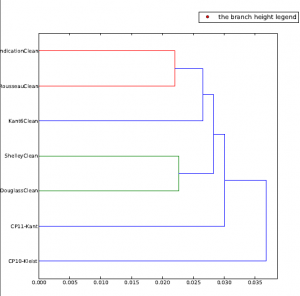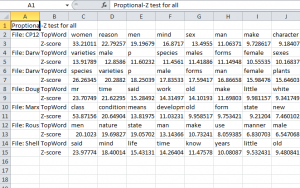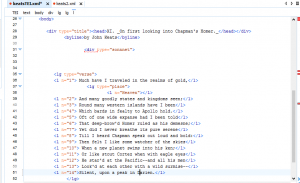http://finalproject.blogs.bucknell.edu/
Author: Tyler Candelora
Tyler Candelora is a first-year student at Bucknell University. He is from Coal Township, PA. He speaks English but is currently learning Spanish, French, and Arabic. Tyler is a comparative humanities and language major.
Man vs. Machine

Machine Reading
As Elena Pierazzo states in her article, A Rationale of Digital Documentary Editions, “The process of selection is inevitably an interpretative act: what we choose to represent and what we do not depends either on the particular vision that we have of a particular manuscript or on practical constraints” (Pierazzo 3). Pierazzo’s view of on the process of marking up texts is similar to our first step within the process of a Distant Reading project – asking which general question you would like to research.
In terms of the Digital Humanities, I believe that the term “Machine Reading” is often misleading. The title implies that only a machine is reading the text and there is no human interaction. However, this is completely untrue. As Pierazzo mentions the process of selecting what you want to mark up within a text is an “interpretative act”. Thus, a human must choose which information within the text is essential to the reader.
Stylometry
Using such platforms as Lexos and TEI – oXygen, I have learned a multitude of new ways to approach analyzing my corpora. Platforms within the field of stylometry can be used to conduct macro-level and/or micro-level research. It is important to recognize the ability to use both Lexos and oXygen in tandem. In other words, you can perform both a distant reading with Lexos and a close reading with oXygen. Therefore, you can do differential analyses, synthesizing the various statistics and interpretations from each platform.
Lexos
Lexos is a great platform that has a myriad of options to clean and investigate your corpora. I was able to upload all of my documents to Lexos with no problems. Then, I had the opportunity to “scrub” my documents of stop words or any special characters. Fortunately, I had the stop word list from Jigsaw that I uploaded straight to Lexos. Then, I was able to visualize and analyze the data of my corpora. Under the visualize tab, there is WordCloud, MultiCloud, RollingWindow Graph, and BubbleViz. Some of the options are similar to other web sites, like Wordle. However, under the analyze tab, there is Statistics, Clustering – Hierarchical and K-means, Topword, etc. The most impressive and useful means to analyze my corpus was through the dendrogram and the zeta-test. Additionally, Lexos can cut and segment your texts into smaller documents by characters, words, or lines. This feature is helpful when using some DH platforms, like Jigsaw, that work better with smaller documents.
Investigating in Lexos
When skyping in with Dr. James O’Sullivan, I was able to learn of countless hermeneutical approaches using the features of Lexos and multi-faceted digital platforms. Stylometrics can produce, as Dr. O’Sullivan stated, “statistically significant” information, pending that the researcher is well-acquainted with his or her texts. Stylometrics supports critical interpretations and close readings. For example, Dr. O’Sullivan showed us the author attribution project used to detect J.K. Rowling’s anonymous books. The digital humanists used dendrograms, which measure texts in terms of similarities in vocabulary, to prove that a text must have been written by a certain author due to the overwhelming statistical evidence.
In Lexos, I made many dendrograms that displayed particular peculiarities in my corpora.
Both dendrograms display texts that I have read in HUMN 150 that are considered post-Enlightenment period. Specifically these dendrograms interest me because there is much similarity in the vocabulary throughout all the post-Enlightenment texts, except Marx, Kant, and Kleist. For example, when we read Frederick Douglass’s narrative, there are specific passages that contain lexicon reminiscent of Shelley’s Creature in Frankenstein. Moreover, Shelley and Douglass are shown to have similar vocabulary in both dendrograms. Even more so, Darwin’s On Origin of Species and The Descent of Man are paired together; this example supports the claim that stylometry produces “statistically significant” information.

However, I was not completely satisfied with the results from my dendrogram. I wanted to create a zeta test which produced the distinctive words in each text based on the 100 MFW (most frequent words). 
As you can see from this zeta test, the first line is Mary Wollstonecraft’s A Vindication of Women’s Rights shows the most unique/distinctive word to be “women” and for Jean-Jacques Rousseau’s Discourse on the Origin of Inequality shows the most unique/distinctive word to be “men.” Rousseau advocated for rights in general for all people during his Discourse. It is in Emile where he makes clear distinctions between men and women. However, the zeta test proves he is clearly still focusing in on men or generalizing the population with a masculine pronoun. (remember this is a translation) Also, these Antconc screenshots show collocations of the terms “women” and “men.” The first is of “women”; the second is “men.” If Rousseau is remaining fairly neutral throughout the Discourse, why does he use the term “men” more than “women”? 

TEI- oXygen Mark-up
I was able to practice micro-level stylometry through XML. TEI is a fascinating way to mark up your text. For example, I marked up a poem by John Keats, and was able to label certain lexical items depending how the author uses specific terms. Also, since you are the person marking up a text, you are picking out whether terms like “realms of gold” connotes “Heaven” or not. You need to understand the poem; it is much more than the machine.
I have marked up Keat’s poem so that each verse could be shown separately for different annotations and meanings. The biggest problem with marking up texts in a semantic way is time constraints. As Pierazzo states, “Which features of the primary source are we to reproduce in order to be sure that we are following ‘best practice’?” (Pierazzo 4) It is evident that a person could tediously mark up a text for an extended amount of time; however, you must ask yourself, “What is the end result?” and “Have I answered, or helped in answering, my research question?
Pierazzo discusses the ways in which TEI helps to minimize the foreignness of the main text and the author. She states, “It is true that a diplomatic edition is not a surrogate for the manuscript when a facsimile is also present, but it is rather a set of functions and activities to be derived from the manuscript which challenge the editorial work and force a more total engagement of the editor with the source document” (Pierazzo 10).
Final Thoughts
Stylometry on both a macro- and micro-level have given me a new perspective on my corpus. Through TEI, I can markup certain texts and find the semantic meanings of specific passages. It is a way to become more familiar with your texts. Also, the dendrograms and zeta tests fill holes in my research that answer questions like, “Compared to Marx and Rousseau who discusses private property straightforwardly?” It is imperative to have both macro- and micro- analysis to give a differential view of the research results.
What if your computer could read your emotions?
The question above has been proposed for many years; however, recently, there has been more attention focused on sentiment and machine analysis. Upon hearing this question, some people enter a state of panic and distress. They assume their computer knows more than they do, thus taking control from human to mechanical hands. Nevertheless, I believe that machines “attempt” to read emotion, but emotion is much more complex than a machine, and even a human, could define.
Emotionless Machines
 According to Stephen Ramsey, “In an age when the computer itself has gone from being a cold arbiter of numerical facts to being a platform for social networking and self-expression,” it is important to understand the programs as a method to facilitate self-expression and networking (Ramsey 81). The programs used online do not create sentiment for you, as the writer, you must create emotion using your language. But can they recognize emotion?
According to Stephen Ramsey, “In an age when the computer itself has gone from being a cold arbiter of numerical facts to being a platform for social networking and self-expression,” it is important to understand the programs as a method to facilitate self-expression and networking (Ramsey 81). The programs used online do not create sentiment for you, as the writer, you must create emotion using your language. But can they recognize emotion?
For example, text messenger or email allows you to talk to someone without having a face to face or ear to phone conversation. You can type what your are feeling and send it to that person. However, how can the person receiving your message understand the tone or inflection of your voice from only text? It is up to the receiver to interpret your message. This is one example of Sentiment Analysis within the Digital Humanities. You can allow the computer to determine systematically the sentiment of the text, but it is up to the researcher to know the material beforehand and make solid conclusions based on both close and distant reading.
Text and email messages adopted emojis – “any of various small images, symbols, or icons used in text fields in  electronic communication (as in text messages, e-mail, and social media) to express the emotional attitude of the writer…”(Merriam-Webster Dictionary). These allow the receiver of a text to understand the sender’s connotation of the message by the expressions of the emoticons/emojis.
electronic communication (as in text messages, e-mail, and social media) to express the emotional attitude of the writer…”(Merriam-Webster Dictionary). These allow the receiver of a text to understand the sender’s connotation of the message by the expressions of the emoticons/emojis.
Is it possible for computers/machines to read emotion?
There are algorithms and platforms that can help a computer read emotion. The algorithms are “trained” by experimentation. One way an algorithm can identify the sentiment of a document or sentence is through a vocabulary. The computer selects the most frequent words from the document or sentence and categorizes them by adjectives, verbs, and negation. The computer is using context clues to locate the emotion. Another way in which an algorithm can identify sentiment is through applying machine learning (ML) techniques. It may treat it as a classification problem, compile the data and set up features to recognize sentiment. Thus, it is possible for machines to read sentiment systematically, although, the question lies with – how well can machines read emotion?
Within the Digital Humanities, we look to step back from the close reading of a text and observe it from a distance or “in another light.” From this we are able to draw differential conclusions. Similarly, the data found with sentiment analysis needs a human to interpret and categorize it. As Ramsey states, “Such numbers are seldom meaningful without context, but they invite us into contexts that are possible only with digital tools” (Ramsey 75). Also, it is important to remember that algorithms are derived from humans.
Topic Modeling
Topic Modeling is a way to strip sentences into individual words. It is possible to discern the semantic meanings of individual words depending on context. The machine chops your text into different parts. The machine is looking for a specific pattern. It looks for the co-occurrence of words within the documents and can compare them to a set of different documents.
When I went through and highlighted my own version of Lincoln’s Gettysburg Address, I realized that my own experiences, either influenced by culture, religion, education, etc., determined how I decided if a word was related to governance (in blue) or war (in red). Likewise, after Ramsey’s students realized their mistakes in categorizing the books of word density, he stated, “They have arrayed the objects of their intellectual life in categories that correspond, among other things, to the cultural penumbras in which texts are disseminated and taught” (Ramsey 73). The manner in which a teacher or professor discusses a book with his/her students can have ramifications with the students’ perceptions of the book.

The topic modeling system has its own experience through a set of documents. Using the program, the bigger the corpus the better it will be. The program will have more reliable information to determine the patterns of the words. Small sample sizes are not ideal, the program will not accurately be able to locate any patterns.
There are also problems with topic modeling. The program can believe it is finding patterns where there are no patterns to be found. You may attempt to extrapolate meaning from the data you get from topic modeling, when in fact you are unable to draw sound conclusions.

It is clear that my own list of topics resemble the keywords not only from my older word cloud, but also the keyness I tested for in Antconc. Each topic line, I had predicted the most significant text and was right every time. It is very interesting how the computer can generate texts similarity through “topics.” Topic Modeling helped me understand just how close in relation some of my keywords throughout my texts are.
Jigsaw & AlchemyAPI
 I received some interesting sentiment analysis from Jigsaw. For example, Pico’s Oration on the Dignity of Man was the “happiest” of my documents. Jigsaw was correct with identifying key words and even more surprising with the summaries. Additionally, Kant was categorized as the “saddest/angriest” of my texts. I know from reading both of these texts that Pico has a “happier” tone than Kant. However, they are not necessarily “happy” texts. Thus, you have to look at the vocabulary that Jigsaw was using to determine the sentiment analysis.
I received some interesting sentiment analysis from Jigsaw. For example, Pico’s Oration on the Dignity of Man was the “happiest” of my documents. Jigsaw was correct with identifying key words and even more surprising with the summaries. Additionally, Kant was categorized as the “saddest/angriest” of my texts. I know from reading both of these texts that Pico has a “happier” tone than Kant. However, they are not necessarily “happy” texts. Thus, you have to look at the vocabulary that Jigsaw was using to determine the sentiment analysis.
Upon closer look in Pico’s book, he uses terms such as “kindness,” “peace,” “natural,” and “holy.” Where as Kant’s  reading has terms like “unworthy,” “tolerance,” and “haughty.” It is imperative that you have read the materials you are using for sentiment analysis, so that you can utilize differential techniques when analyzing the data.
reading has terms like “unworthy,” “tolerance,” and “haughty.” It is imperative that you have read the materials you are using for sentiment analysis, so that you can utilize differential techniques when analyzing the data.